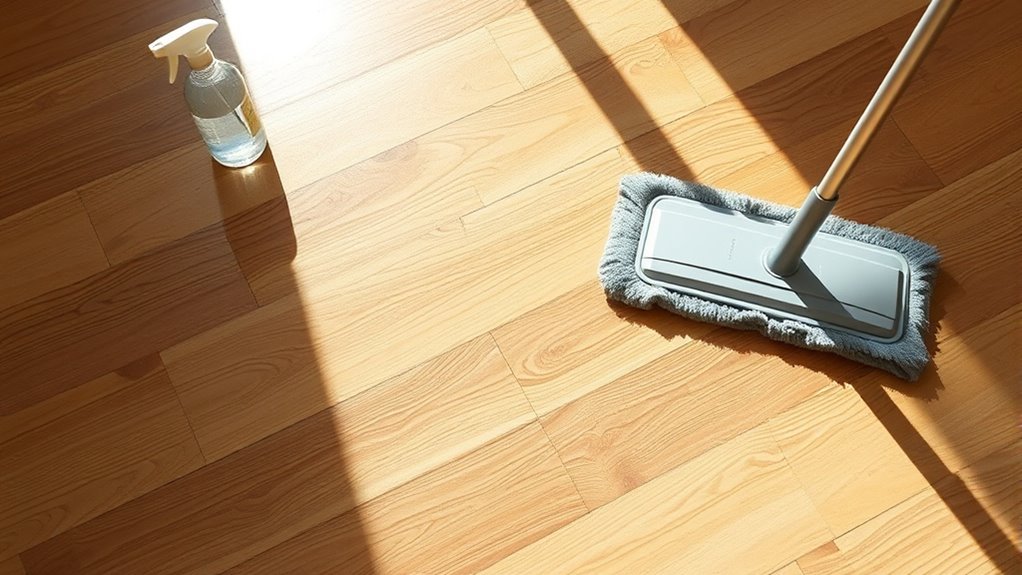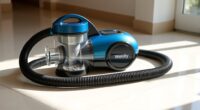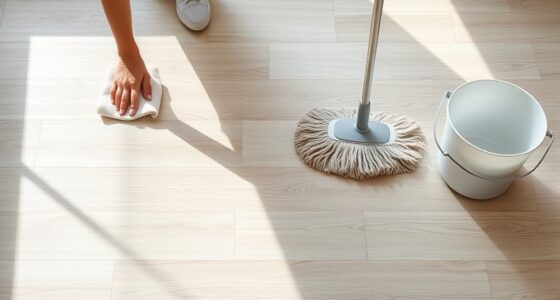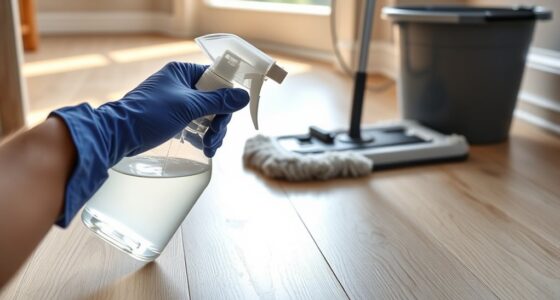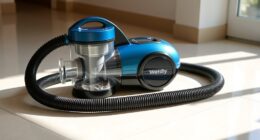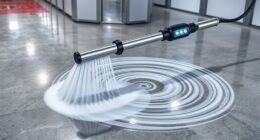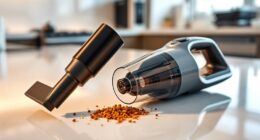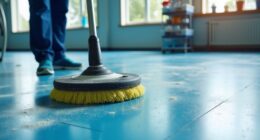One common mistake is using improper mop techniques, like bulky mops that leave too much water, causing damage over time. Using harsh or inappropriate cleaning products can also weaken your hardwood’s finish, while applying too much solution leads to sticky buildup. Neglecting regular sweeping or vacuuming allows dirt to scratch the surface. To protect your floor, use microfiber mops, pH-neutral cleaners, and stick to a routine. Keep these tips in mind to guarantee your floors stay pristine—there’s more to discover to avoid costly mistakes.
Key Takeaways
- Avoid using sponge or bulky string mops that leave excess water on the floor, causing damage over time.
- Use pH-neutral, hardwood-specific cleaners and avoid harsh chemicals like ammonia or bleach.
- Dilute cleaning solutions properly and never apply excessive amounts, which can lead to residue buildup.
- Regularly sweep or vacuum to remove dirt and grit, preventing scratches and maintaining floor integrity.
- Always wring out your mop thoroughly and dry the floor after cleaning to prevent moisture damage.
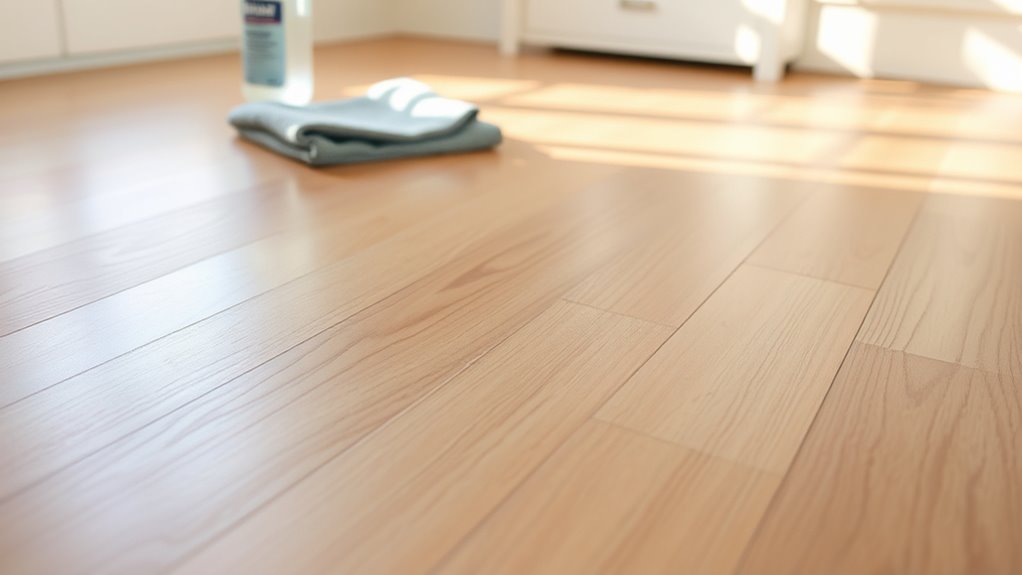
Sealed hardwood floors are prized for their durability and easy maintenance, but even with a sealant in place, improper cleaning can cause damage. One common mistake people make is using the wrong mop techniques. You might be tempted to grab a traditional sponge mop or a bulky string mop, but these can leave excess water on the surface, leading to warping or dulling over time. Instead, you should opt for a microfiber mop that effectively traps dust and dirt without pushing water into the seams. When mopping, make sure you use gentle, overlapping strokes and avoid saturating the floor with water. Wring out your mop thoroughly before each pass, and never leave pools of liquid sitting on the surface. Proper mop techniques are essential to prevent water from seeping into the seams, which can cause swelling or damage to the wood beneath the sealant.
Use a microfiber mop with gentle strokes and avoid excess water to protect sealed hardwood floors.
Another mistake involves the use of inappropriate cleaning products. Many homeowners reach for general-purpose cleaners or harsh chemicals that aren’t designed for hardwood floors. These products can strip away the finish or cause discoloration over time. Instead, you should choose cleaning products specifically formulated for sealed hardwood. Look for a pH-neutral cleaner that cleans effectively without damaging the sealant. Always read labels carefully and avoid products containing ammonia, bleach, or abrasives, as these can weaken the finish and leave your floors looking dull.
Additionally, applying too much cleaning solution is a common error. You might think more product means a cleaner floor, but excess cleaner can leave a sticky residue that dulls the surface and attracts more dirt. Use a small amount of cleaner diluted in water, following the manufacturer’s instructions, and always wipe with a damp, not soaked, mop. After cleaning, dry the floor with a clean, soft cloth or a dry microfiber mop to remove any remaining moisture and prevent streaks or water spots.
Finally, neglecting regular maintenance can lead to more significant issues. Sweeping or vacuuming regularly helps remove dirt and grit that can scratch the surface when walked on. Combining proper mop techniques with suitable cleaning products creates a routine that preserves your sealed hardwood floors’ natural beauty and longevity. Staying mindful of these mistakes—and fixing them with simple adjustments—ensures your floors stay stunning for years to come, avoiding unnecessary damage and costly repairs.
Frequently Asked Questions
Can I Use Vinegar on Sealed Hardwood Floors?
Yes, you can use vinegar cleaning on sealed hardwood floors, but do so sparingly. Mix a small amount of vinegar with water for gentle hardwood maintenance. Avoid using full-strength vinegar, as its acidity can damage the finish over time. Always test a small area first, and never soak the floor. Properly diluted vinegar helps you clean effectively while preserving your sealed hardwood’s shine and durability.
How Often Should I Deep Clean Sealed Hardwood?
Think of your floor as a well-loved book, needing gentle turns to keep its story alive. You should deep clean your sealed hardwood every 4-6 months, like revitalizing its pages. During this time, incorporate floor polishing to restore shine and remove pet hair that settles like dust in the corners. Regular gentle cleaning keeps your floors vibrant, protecting their story and your home’s warmth.
Are Steam Cleaners Safe for Sealed Hardwood?
Steam cleaning can be safe for sealed hardwood if used properly, but you need to be cautious. Excessive steam or high heat can cause hardwood damage over time. Always verify your steam cleaner has a low-pressure setting, and avoid staying in one spot too long. Test a small area first to prevent warping or swelling. When used carefully, steam cleaning can effectively sanitize your sealed hardwood floors without causing damage.
What’s the Best Mop Type for Sealed Hardwood Floors?
You should use a microfiber mop for sealed hardwood floors because it’s gentle and effective. Microfiber cleaning tools pick up dirt without scratching the surface, making them ideal for delicate finishes. Avoid using string mops or overly wet cleaning tools, as excess water can damage the wood. Opt for a mop with a washable, soft pad, and always wring out excess moisture before cleaning to keep your floors looking pristine.
How Do I Remove Stubborn Stains From Sealed Hardwood?
Sure, stubborn stains love your hardwood’s attention, but you can outsmart them. Start with gentle wood stain removal methods—like a mixture of baking soda and water—applied softly with a soft cloth. Avoid harsh chemicals that only tempt future stains. To prevent more, clean spills immediately and use mats. Remember, stain prevention beats endless scrubbing, and patience is your best tool for maintaining those beautiful, sealed hardwood floors.
Conclusion
Ignoring proper cleaning techniques can shorten your sealed hardwood’s lifespan by up to 50%. Many people unknowingly damage their floors with common mistakes like using too much water or harsh cleaners. The good news? Simple fixes like using a damp mop and gentle cleaners can keep your floors looking beautiful for years. So, next time you clean, remember these tips to protect your investment and enjoy a stunning, durable floor every day.
